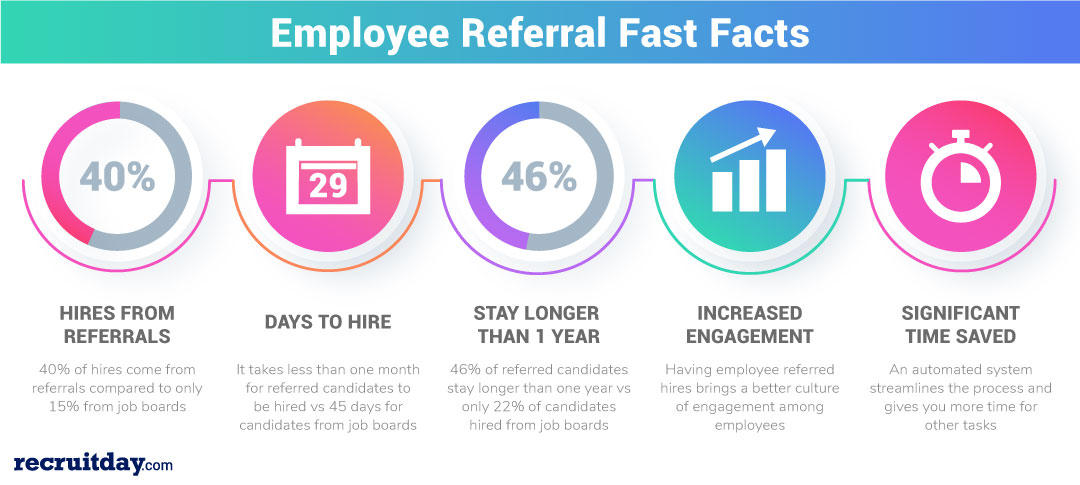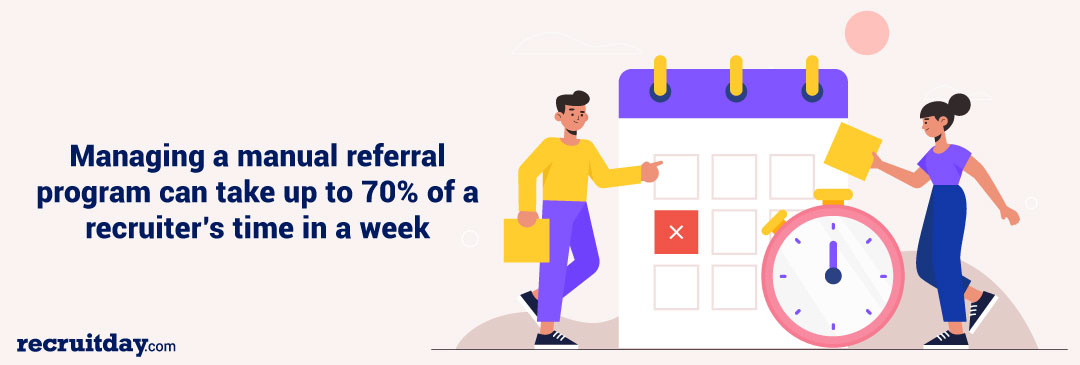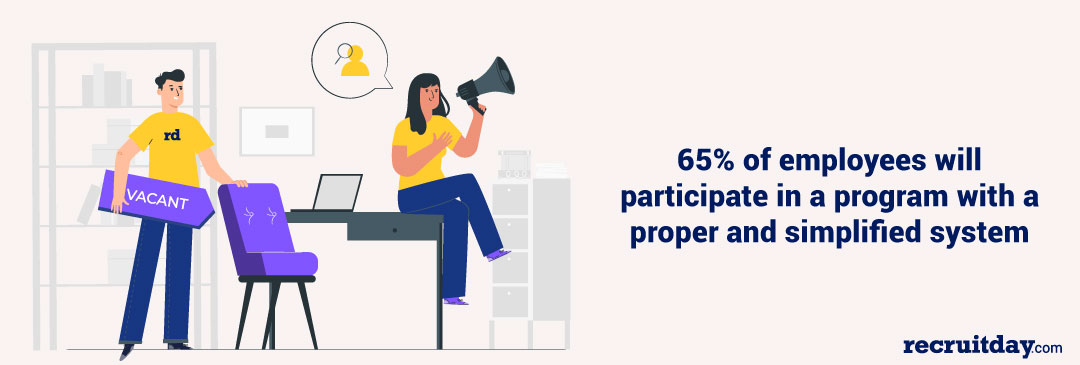EMPLOYERS/HR
WHY IMPROVING EXPERIENCE IS THE KEY TO A SUCCESSFUL EMPLOYEE REFERRAL PROGRAM
MARCH 24, 2021

Business photo created by marymarkevich - www.freepik.com
Let's get down to it: Good candidate and employee experience created through a proper system and automation results in a more successful referral program, which in turn results in more cost savings and a shorter time to hire.
We’ve heard it before - employee referrals are a top source of quality hires. They save you time and effort, cost less than other recruitment methods, and all the other good stuff. But if employee referrals are so great, why don’t more companies run referral programs?
Without a doubt, referrals are an effective channel for your recruitment strategies. But one of the main reasons referral programs aren’t always successful is simple - employees and candidates have a bad experience and do not engage with the program.
So, what is the solution?
We can argue that this is where automation and a reliable employee referral system come into play. When you have a proper system, your employees and the candidates will have a good experience and are more willing to engage with the program. As a result, it will ease your time spent managing the program and reduce your overall cost per hire.
Let’s talk about how a good experience through automation and a proper system can better engage employees and help create a more successful referral program.
GENERAL BENEFITS OF EMPLOYEE REFERRALS

Multiple data sources have stated that through employee referrals, you end up with higher-quality candidates that are faster to hire and quicker to onboard. These candidates also stay longer and are more engaged.
The thing is that you can only get those benefits if all parts of the program line up correctly. While this may be possible with a traditional or manual referral program, the chances for success are greater when you maximize all the resources you have - such as an automated system.
PROBLEMS WITH TRADITIONAL EMPLOYEE REFERRAL PROGRAMS
'Traditional employee referral programs' refers to programs done manually through spreadsheets, calendar reminders and tracking, manual notifications, and good old fashioned super organization.
While this may be manageable for a small company, the more employees you have, the more difficult it will be to stay organized and effectively manage the program.
Let’s look at the first aspects most companies will consider – the costs.
A company that has 1,000 employees, will need an average of three to five recruiters or HR professionals to efficiently manage the program manually.
Consider how much this would cost if you pay one employee P20,000 per month:
- 20,000 x 3 employees x 12 months = 720,000 a year
- 20,000 x 5 employees x 12 months = 1.2 million a year
Add in other expenses such as the benefits you offer, allowance, reimbursements, office space costs, free meals, etc. and that amount could easily multiply. However, relying solely on cost isn’t the best indicator of how well your program will perform and how much you will spend in total. There are too many factors in play when it comes to cost, beyond just the recruiter's salary, such as the time spent by recruiters to find candidates.
You need to remember is that looking for new hires is not the ONLY responsibility of your human resource or talent acquisition team. This brings us to our next point - the TIME cost.

Calendar vector created by pikisuperstar - www.freepik.com
Managing a manual referral program is very time consuming
According to recruiters at a RecruitingDaily event, managing a program can take up to 70% of their time in a week. Considering HR personnel have other tasks other than simply recruiting, this puts a great deal of pressure on them.
This is how the referral recruitment process might look like if done manually:
- The recruiter receives referrals through email
- Go over candidates to see if they are qualified
- Contact candidate through whatever channel provided (email, phone, social, etc.)
- Input details on a spreadsheet
- Notify employee who referred about their candidate
- If there is a change, update the status on the spreadsheet
- Update employee again about the change
- Set calendar reminder for payouts
- Answer questions from employees about their payout (again, keep them updated)
- Facilitate payout when it’s time
Just reading that is exhausting. Not only does the entire process take a lot of time, but all the extra steps also make it more likely for errors to occur.
In a manual program, recruiters must manage, organize, and track everything through spreadsheets and calendars. They also might have to switch between multiple messaging channels to talk to the employee and the candidate. And most of all, they need to reply to inquiries and status update requests from employees. This is a key factor for the overall experience of the employee.
Because there are so many steps involved and not enough time to do them, the entire process might take longer. And the longer it takes to hire a candidate means more time spent, which also means more cost. You have to spend more time, money, and energy as the days progress.
To make matters more challenging, when a job seeker sees openings that are over a month old, they tend to pass on that listing, further diminishing your chances for a successful hire.
Mistakes, no updates, and missed payouts lead to unsatisfied employees
Because recruiters and HR personnel will be hard-pressed for time on a manual program, more mistakes are likely to happen, as well as possible missed updates, and missed payouts.
The dangerous thing about this is that it will lead to unsatisfied employees. And when your employees are not happy with the program, they won’t refer. If they won’t refer, you won’t get candidates, and essentially, your entire referral program would go to waste.
This circles back to the importance of the experience for your employees.
So the MAIN challenge is in employee experience, engagement, and participation
Getting employees to engage with a referral program is a common challenge many companies face. There are multiple factors involved, but it boils down to misplaced priorities that lead to a poor experience.
Companies often put all their focus on trying to improve the cost per hire and shorten the time to hire, however, trying to improve cost per hire and time to hire do not CAUSE or CREATE more referrals. They are a by-product of a good program and good sourcing.
And the way to create a good program and good sourcing is through the right experience, which we can argue is highly achievable with an efficient and automated system.

Work vector created by stories - www.freepik.com
THE SOLUTION IN AUTOMATION
How automation improves the experience
The best way to maximize referrals, you need to leverage the technology available. Spreadsheets and calendars may have been fine back then, but why settle for fine when technology offers a better way?
Instead of setting up tables, answering inquiries one by one, constantly updating employees, checking your calendar for the schedule of payouts, let an automated system do all that it can for you. This leaves you more time to focus on other tasks that demand your energy.
Some ways an automated system can help are:
- All applications in one place
- All communications and messaging in one place
- Easier to collaborate with teammates and employees
- Track everything faster
- Report generation to see how well your campaigns are performing
- Data organized for you
- Notifications and reminders when you need to pay
…and so much more, depending on the software you choose.
The goal is to improve the experience
Our data shows that 65% of employees will participate in a program with a proper and simplified system because referring is easier. Compare it to running the referral program manually, which only has a 15% or less participation rate. With a proper and automated system, an employee will refer about 6 - 7 candidates per year.
What this tells us is that employees are more eager to refer when they receive real-time updates about their referrals because they feel there is progress.
Another useful thing to look at is a system that enables social sharing for branding impact. Essentially, branding impact equates to how many candidates see the job. To increase views of the job, it’s important to have a social component to the program.
Because everyone is on social media, it is a great channel to maximize views by both active and passive candidates. If this communication channel is easily accessed through the app, product, or system you are using, it encourages employees to share the job even further to their social and professional networks. The more people see your jobs, the more will apply.
THE RESULT IS A THRIVING AND SUCCESSFUL REFERRAL PROGRAM
In the end, the overall cost per hire and time spent will adjust based on how good the experience, participation, and engagement of your employees are. While there are numerous things you can do to improve each of these aspects, choosing a proper and automated system is the best first step to take.
Remember that the better the experience, engagement, and participation, the better your cost per hire and time to hire will be, NOT THE OTHER WAY AROUND.
A successful program means you get a continuous stream of candidates who have been vetted or “pre-approved” by your employees, allowing you to maximize the power of their referrals. But remember, it all starts with the experience.
Need help recruiting?
SEND US A MESSAGE | POST A JOB FOR FREE | LEARN MORE ABOUT OUR SOLUTIONS
Contact us now for any questions or concerns and we will reach out to you as soon as we can!
MARCH 24, 2021
Looking for tech talents to join your team?
Let our team help you recruit, connect, and hire only the best people for your tech job openings. Send an inquiry now!



